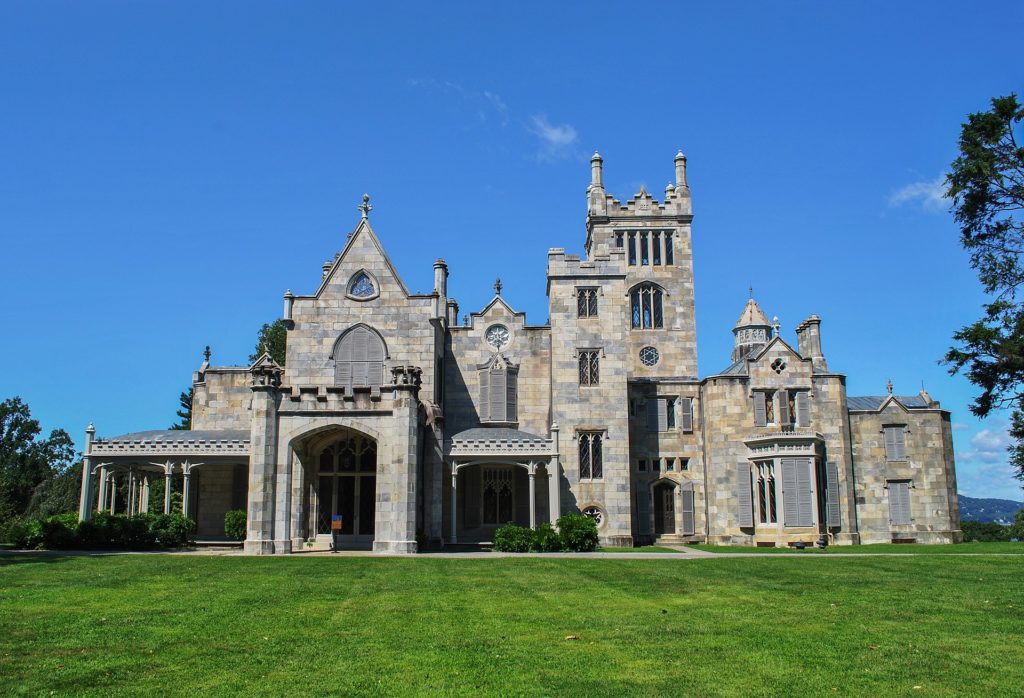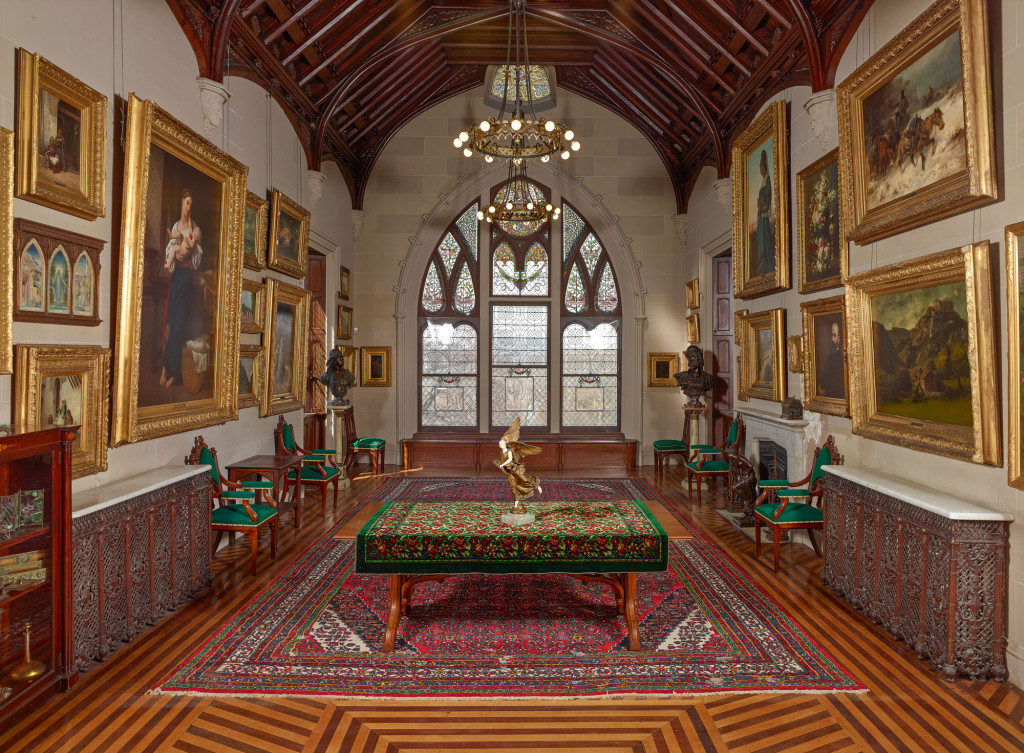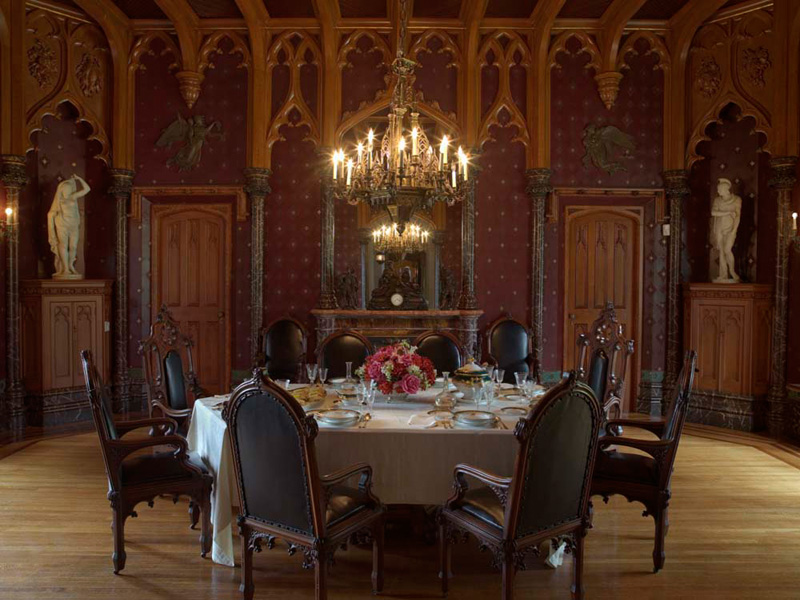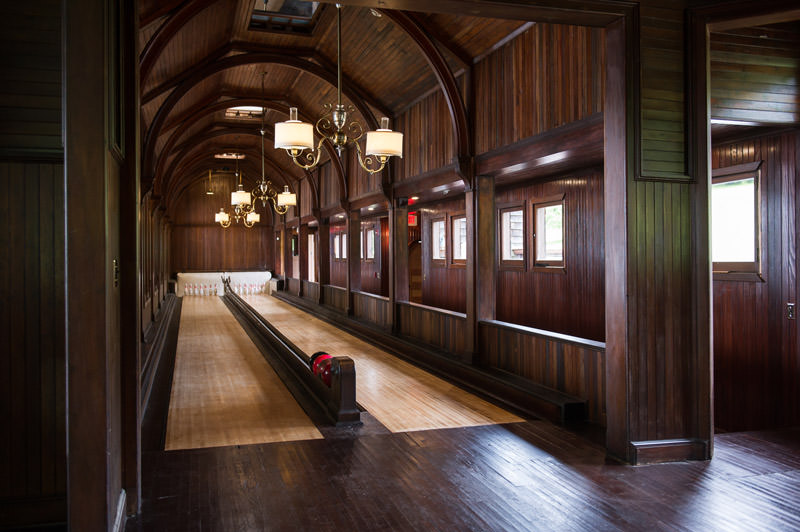Explore the home of Jay Gould and his daughters, Helen and Anna

Apple | Spotify | Stitcher | Transcript | Email | Bonus Episode
Listen to the 12-minute bonus episode for Lyndhurst Mansion which includes recordings and stories I couldn’t fit in the original episode. We go to the observatory on top of the house, learn about the interior of Jay Gould’s yacht, and learn more about his childhood friendship with John S Borroughs. You can listen by joining Someone Lived Here’s Patreon at any level.
In this episode of the podcast Someone Lived Here, Kendra brings you to Lyndhurst Mansion in Tarrytown, NY. The mansion was built by a former New York City mayor William Pauling and designed by the architect Alexander Jackson Davis. It was then purchased by the Merritt family who doubled the size of the home by commissioning the same architect. Jay Gould, a robber baron, purchased the home. Upon his death his daughter Helen and later his daughter Anna would take over the property. Anna Gould donated the property to the National Trust for Historic Preservation upon her death.
In this episode, we tour the library, dining room, and art gallery of the mansion, along with the bowling pavilion. As we walk through the property we learn more about who Helen and Anna were, their differences, and their combined interest in keeping Lyndhurst standing.
Thank you to Rick Hostnik and Maura Bekelja for showing us around the property. You can sign up for tours and learn more about the mansion and the grounds at the Lyndhurst site.



Music by Tim Cahill. Icon artwork by Ben Kirk. Transcription by Sam Fishkind.
Below is a transcript for season 1, episode 5 of Someone Lived Here on Lyndhurst Mansion in Tarrytown, NY. If you have any questions about the show or suggestions on how to make it more accessible please reach out at someonelivedhere@gmail.com.
Kendra Gaylord: This week, we’re at Lyndhurst Mansion, located in Tarrytown, New York. The home was owned by three influential men: a New York City Mayor, a businessman, and Jay Gould, one of history’s most hated robber barons. But it was two sisters, Helen and Anna, who ensured that this home is still standing today. Welcome to Someone Lived Here, a podcast about the places cool people called home. I’m your host, Kendra Gaylord. Every other Monday this season, we’re bringing you to a cool place in New York and telling the complicated stories of the people who once lived there.
Kendra Gaylord: Today we’re at a property where the word “mansion” is an understatement. It’s in the Gothic Revival style and looks closer to a castle; complete with turrets, stained glass and a gray limestone exterior. When driving toward the mansion through the park (which totals 67 acres), there are beautiful magnolia and willow trees. Behind the mansion is the Hudson River, where Jay Gould used to make the daily trip to New York City on his yacht. The first owner was William Paulding. He was a former mayor of New York City and built the original mansion as his retirement home in 1838. The architect, Alexander Jackson Davis, originally built a 7,000 square foot home, which sounds extremely big, but it’s more just really big; a little less than two basketball courts. We’ll be walking through the home with Rick Hostnik. He’s the tour guide here at Lyndhurst and is going to help us unravel who lived here, what they valued, and try and explain the fancy things we’re seeing. We’ll be starting in the library.
Rick Hostnik: Significant in this room in particular, there is a Tiffany lamp that belonged to the Gould family. There are also bookcases filled with Jay Gould’s books from the 19th century and earlier. Of significance, they sit in beautiful oak bookcases that were created by the architect, Alexander Jackson Davis. And these were beautifully hand-carved. When you look very closely at each one of these shelves, both in this room; and there’s an adjacent room that is an extension of the library: all of the shelves are numbered and all of the books are cataloged.
Kendra Gaylord: There is something very special about these bookshelves, which I think should become more commonplace. They have a riser on the back half of each shelf, so you can have two layers’ worth of books, but can see the names of the books in the back AND the front. William Paulding passed away in 1854 and the home was sold to the Merritt family.
Rick Hostnik: The Merritt family wanted a grand home. This was a summer home for them. They wanted a grand, beautiful, elegant summer home that reflected how wealthy they were. Mr. Merritt decided he was going to hire the original architect, Alexander Jackson Davis, to come back up to Tarrytown and add on to the original house. Mr. Merritt wanted what he called a “seamless addition” put onto his house. He didn’t want a home that looked like it was added on to. He wanted a home that appeared as if it was built all as one. So, who better to achieve that than the original architect?
Kendra Gaylord: The architect doubled the size of the home, and there was one thing that really mattered to the Merritt family: to have a dining room designed for entertaining.
Rick Hostnik: So, Davis did provide the Merritts with a big, beautiful dining room that is quite extraordinary on a couple of different levels. First of all, we are in a room with ceilings that are almost 14 feet tall. It is quite a large, elegant room with a big, beautiful table and 14 hand-carved chairs in the center. This furniture that we have here is a beautiful set of oak furniture that was designed again by the architect Alexander Jackson Davis. In this case, this dining room furniture was created for the Merritt family. When the Merritt family passed away, this furniture was actually sold to the Gould family when they purchased the home. The room decoration, the interior decor in this room, it is an example of something called trompe-l’œil. This concept of hand-painting surfaces to make them look like something they’re not. And this room is filled with those kinds of treatments; from the ceiling to the beams, to the walls, to the columns that surround this beautiful room.
Kendra Gaylord: I specifically love the walls of this room. It’s a deep burgundy color with a diamond-shaped pattern. I assumed it was wallpaper, until I got closer and you can see the brushstrokes. It’s an elaborate pattern done with a stencil. We’re going to walk upstairs and look at one of the most remarkable rooms. It’s the space that Lyndhurst is most famous for: an art gallery complete with wooden cathedral ceilings, a gigantic stained glass window and the art collection of the Goulds.
Rick Hostnik: We are in now what is actually the largest room in the house, and when the house was built in 1838; this was where the library was. Mr. and Mrs. Merritt converted it to an art gallery to show their rather extensive collection. What is hanging here now at Lyndhurst is the art collection of Jay Gould.
Kendra Gaylord: The art in here is beautiful, but there’s something else in this room that makes your jaw drop.
Rick Hostnik: The art gallery has magnificent windows; beautiful stained glass windows, arched windows. We have a beautiful view of the Hudson River. What currently is here in the art gallery is another example of Tiffany.
Speaker 2: Yes, he said another. I didn’t mention it before, but almost every window in this house is Tiffany stained glass. The same Tiffany whose lamps show up on Antiques Roadshow valued over $100,000. The details on these windows are remarkable. This home is absolutely massive and we could get lost in here for days, with only Tiffany lamps to guide our way out. We’re now going to head outside and learn more about Jay Gould and his daughter Helen. We’ll be talking with Maura Bekelja. She was previously the Marketing and Digital Communications Coordinator at Lyndhurst.
Maura Bekelja: Something you can see peeking out through those trees is Jay Gold’s yacht bridge. So when he wanted to go into the city from here, he would cross his yacht bridge over the railroad rather than take the train in and he would take his yacht down the river to Manhattan; to Wall Street, do his work, and come home at night. He gets a terrible reputation for manipulating the gold market and his business practices. But he came home every night on his yacht and crossed that little bridge, and walked up the hill and ate dinner with his family. So it’s a strange man, you know, for that time, but we get to see here…only the good side of him.
Kendra Gaylord: Maura mentioned Jay Gould’s reputation, and to this day he has one of the worst. There’s a cartoon that best explains it, titled Jay Gould’s Private Bowling Alley. He’s bowling with balls labelled “trickery”, “false reports”, “private press”. The pins are bankers, stock dabblers investors, and the street he’s playing on his Wall Street. This cartoon was published in Puck, a humor magazine that ran from 1871 to 1918. The cartoons in Puck help you understand how Gould was perceived, but Gould wasn’t the only man depicted in these cartoons. Vanderbilt and Gould sitting on top of a raft with their millions, being carried by tired iron and lumber workers; Andrew Carnegie with 20 million dollars being pumped into each of his pockets with the title “Why Can’t They Be Content With The Half They Make Honestly?”, Or John D. Rockefeller at a keyboard overlooking Congress, conducting them with his prompt book. In the height of their careers, all of these men had reputations. Rockefeller and Carnegie would spend the last 30 to 40 years of their lives giving gigantic donations. This helped them ensure that “robber baron” isn’t included in their Wikipedia listing, but philanthropist is. Jay Gould died at age 56 of tuberculosis. His wife had died three years earlier. This left his eldest daughter, Helen, heading the estate at age 24. And the first thing she built was a bowling alley. This one is located on a shady green lawn, not on Wall Street.
Maura Bekelja: So this building we’re coming up to is the Bowling Pavilion. We say bowling alley and you kind of think of like “The Big Lebowski”, and they all kind of look the same. This is one of the first regulation-size bowling lanes in America. This is built in 1894. Helen Gould built this, and a lot of the buildings that we see were built by Helen Gould. She wanted this to be a recreational space. So this was a space that she used not just for bowling but also as her sewing school. And what her sewing school did was it took children from the community and her own staff. She taught them how to sew so that they could have some form of economic independence; so they would be able to go out into the workforce with a usable skill. She was really about empowering women to be able to have those kinds of skills that would let them have a nicer life. And so that’s sort of where her sewing school came about. And it was also I think an opportunity to teach some of the religious proverbs ’cause a lot of what you would so were, you know, little quotes from the Bible. So she sort of got, you know, both things in there, and was able to have an impact on the community that way.
Kendra Gaylord: We’re inside the Bowling Pavilion now and Maura is right. This bowling alley is much nicer than the one in “The Big Lebowski” and has a lot more natural light.
Maura Bekelja: Part of why Helen built a bowling alley and not like, I don’t know, football field or something else was that women and men could play; could bowl, equally. You didn’t have to wear special clothes. You didn’t have to…you weren’t up against somebody who you couldn’t possibly beat. It was very much just an aiming and, you know, getting it right kind of thing. So she was very much about being able to entertain people in the same space. And so, she chose bowling because you could come here in the same clothes you were already wearing, with your husband and your friends and you could all bowl and have fun equally. So, that’s part of why she decided bowling was going to be the building that she built. And we actually restored this just recently, and it can be bowled on. So; it is a regulation lane, the pins and the balls are modern because the original ones – they’re very fragile. You would have two young people, usually boys, at the back, they were called “pin boys”, and they would reset the pins and return your ball for you, ’cause this was before the mechanical pin setter existed. So these are – we only use 7 lb balls to keep the floor from getting super dented.
Kendra Gaylord: So we’re about to go bowling!
[Sound Effect]: [A bowling ball is bowled across a floor. It rolls, then strikes the pins with a resounding clatter.]
Maura Bekelja: Oh, that was really good.
Kendra Gaylord: I got a couple!
Maura Bekelja: Yeah! So then I have to walk down the gunner…
[Sound Effect]: [Footsteps moving away]
Maura Bekelja: So then they would put the ball on this little ram and send it back using gravity.
[Sound Effect]: [Ball rolling toward the microphone; followed by a wooden clunk.]
Kendra Gaylord: So, while Helen was here in Tarrytown making a Bowling Pavilion and rolling strikes, her sister Anna was moving to Paris. She married a French nobleman at 20, moved to France, and started having children. We’re going to learn more about Helen and Anna’s lives, but first I wanted to know more about whose stories have been of interest over the years.
Maura Bekelja: A lot of how this house was originally marketed…especially I would say in the 90’s; was this was Jay Gould’s mansion. And that’s what appealed to people. People read about him, they learned about him in history class and they wanted to see how the 1% lived; the robber barons. They were very fascinated by that history of, you know, the men who built America. And not that that isn’t an interesting story because it is, but it’s not the full story, and it’s not how Lyndhurst got to be where it is. Jay Gould…he bought Lyndhurst, he lived here. He loved it. He was hugely responsible for the greenhouse. But there’s a whole history of Lyndhurst after he passed away and before he came here. So we are not turning away from Jay Gould at all, but we are turning toward his daughters in part because they’re responsible for leaving us so much in such good care. But also because they’re super interesting people. They had really fascinating lives and they were two very… for sisters, two very different people – completely different trajectories in life. And I think it’s really relatable to know that these two people came from the same situation and ended up in very different places – and then at the same place at the end of their life.
Kendra Gaylord: One of the amazing parts of the Lyndhurst collection is Helen and Anna’s clothing.
Maura Bekelja: A lot of that was just put in storage, because it was like “it’s clothes”, and it wasn’t until our Executive Director Howard came and sort of looked at it and was like, “these are couture, museum-worthy pieces of clothing that tell a story about how women’s lives were changing at the turn of the century.” To be able to say “that’s not just a dress: that’s a day dress from 1913, and if you look at the day dress from 1885 you can see how different everything is,” but it’s about having that fresh perspective.
Kendra Gaylord: In 2016 Lyndhurst had an exhibition of Helen and Anna’s clothing. Seeing what they wore really helps you understand who they were. Helen was often in high quality pieces with nice tailoring in neutral palettes. Anna on the other hand liked frills, soft colors and florals. Her pieces looked very youthful. The best example of this is a pink dress with a crinoline skirt and giant pink flowers that work their way up, with the final flower landing on the shoulder. It’s something you might see on a flower girl, and Anna wore it in her seventies. Anna was 20 when she moved to France. She had married Count Boni de Castellane in Manhattan, which meant that she would retain her fortune and have the option to divorce. She had five children with this husband, and they divorced in 1906 when it was estimated he spent 10 million of the family fortune. Two years later, and it would marry her ex husband’s cousin, who wasn’t just a count, but was French royalty. He carried the titles of “Prince” and “Duke”, making Anna the Duchess of Talleyrand. She had two children with her second husband whose name I would say if it wasn’t so hard to pronounce. During this time, Helen was going a very different route. She purchased the property outright from her siblings. She studied law at NYU. She was a champion for women’s economic equality and handled a lot of her father’s outstanding business. At 45, many assumed she would never marry. Then she met Finlay Shepard. He was a railroad executive, and the two got married at Lyndhurst. She wore a floor-length, long-sleeved white dress. Her sister Anna gifted her a handmade lace veil from France that trailed on the floor. Finlay and Helen would adopt four children. The years passed, and their children grew up and so did they. Anna’s husband died in 1937 after 29 years of marriage. The next year, Helen died at age 70. The home was then passed to Anna. Anna would leave her home in Paris and return to the United States. World War II was just beginning. She assumed it would be a short trip, but she would stay for 20 years. She lived at the Plaza Hotel in New York City, but kept Lyndhurst fully staffed and prepared for visits from herself and the family. At 86, Anna would return to Paris and die there six months later. In her will, she left Lyndhurst, its contents and all of its land to the National Trust for Historic Preservation. Lyndhurst Mansion is open for tours Thursday through Monday. The grounds of Lyndhurst are open from 9:00 AM to 5:00 PM every day.
Kendra Gaylord: Thank you for listening to Someone Lived Here. I’m your host, Kendra Gaylord. Be sure to subscribe so you can hear the next episode on the Edgar Allan Poe cottage in the Bronx. Thank you to Rick Hostnik and Maura Bekelja, and the team from Lyndhurst Mansion, and the National Trust for Historic Preservation. Music is by Tim Cahill and podcast artwork is from Ben Kirk. If you have any notes or recommendations for the show, send us an email at someonelivedhere@gmail.com. To learn more about the show. Go to someonelivedhere.com and follow us on Instagram.